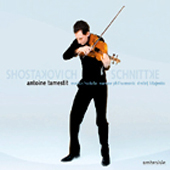
ESSENTIAL RECORDINGS

A Russian composer who lived from 1934 to 1998, Alfred Schnittke wrote this concerto in 1985, the year that Gorbachev came to power in the Soviet Union, ended the Cold War and allowed Russians once again to enjoy the freedom of travel. Schnittke left Russia and settled in Hamburg.
Things were looking up so why is the music in this great work so terrifying.
The opening movement, the first Largo, begins with solo viola very slowly and quietly peering through the darkness. Very so gradually a fear, a sense of horrific dread slowly takes hold of the music, and just after 3 minutes in, what was being feared rears it's ugly head and the full
orchestra unleashes a massive, terrifying chord that will make you look over your shoulder and feel cold rushing down your spine. The atmosphere of most of the work is full of threatening shadows, massive outbursts, frantic viola passages and demonic cries of pain from the bowels of the orchestra.
Now and then though, some beautiful, soaring lyricism takes over and calms the fears. One fine example, is when the piano within the orchestra plays what sounds like the bass line to Schubert's Ave Maria, with the viola high above playing a plaintive, passionate melody, full of melancholic beauty.
Here and there the use of military side-drums is very effective at adding to the anguish already present. The mood of the final Largo movement is more relaxed, although still gloomy and desolate, and the last few drawn out notes on the viola seem to represent life passing away.
Both Tamestit and Kitajenko own this music. In fact, Antoine Tamestit chose to record the Schnittke because it was dear to his heart. It changed his life after he won the Munich Viola Competition performing it, astounding everyone by playing it from memory. Because of the passion within the music,
it must be difficult sometimes to achieve perfect balance between the soloist and the orchestra in works like this, but this performance and recording do just that and more. And the filler on the CD, if you can dare call it a filler, is the sublime Viola Sonata by Shostakovich, performed with the same
passion, devotion and spunk. The recording was released in August 2008.
Let me finish by saying that for a work composed near the end of the 20th century, the Schnittke concerto is a very accessible piece of music that impresses from start to finish and never stops to communicate it's intent and emotions, in a very human language.
The music seems to foretell tragic events and a week after finishing it, Schnittke suffered the first of a terrifying series of strokes that would eventually kill him. It was the beginning of the end. - Richard Jones
It's scary how it is like this. The end of the concerto feels like a breathing that just stops. This is the reason why I put the Shostakovich Sonata on the CD. For me it makes the same kind of arch, slow, fast, slow with a very long last movement, but also of course for Shostakovich it was the end
of the end. He died a month after completing the sonata. - Antoine Tamestit
Jean-Yves Duperron